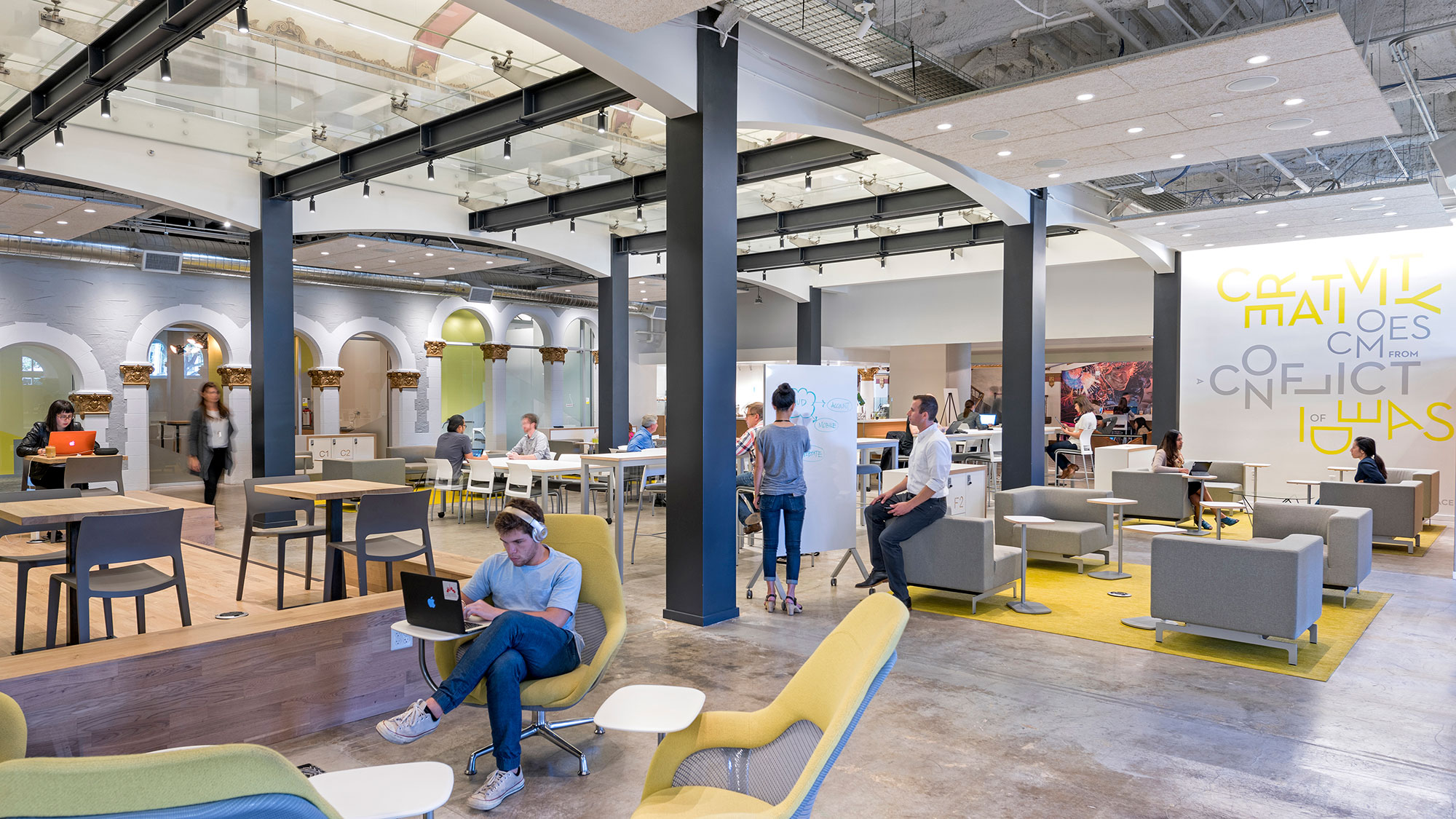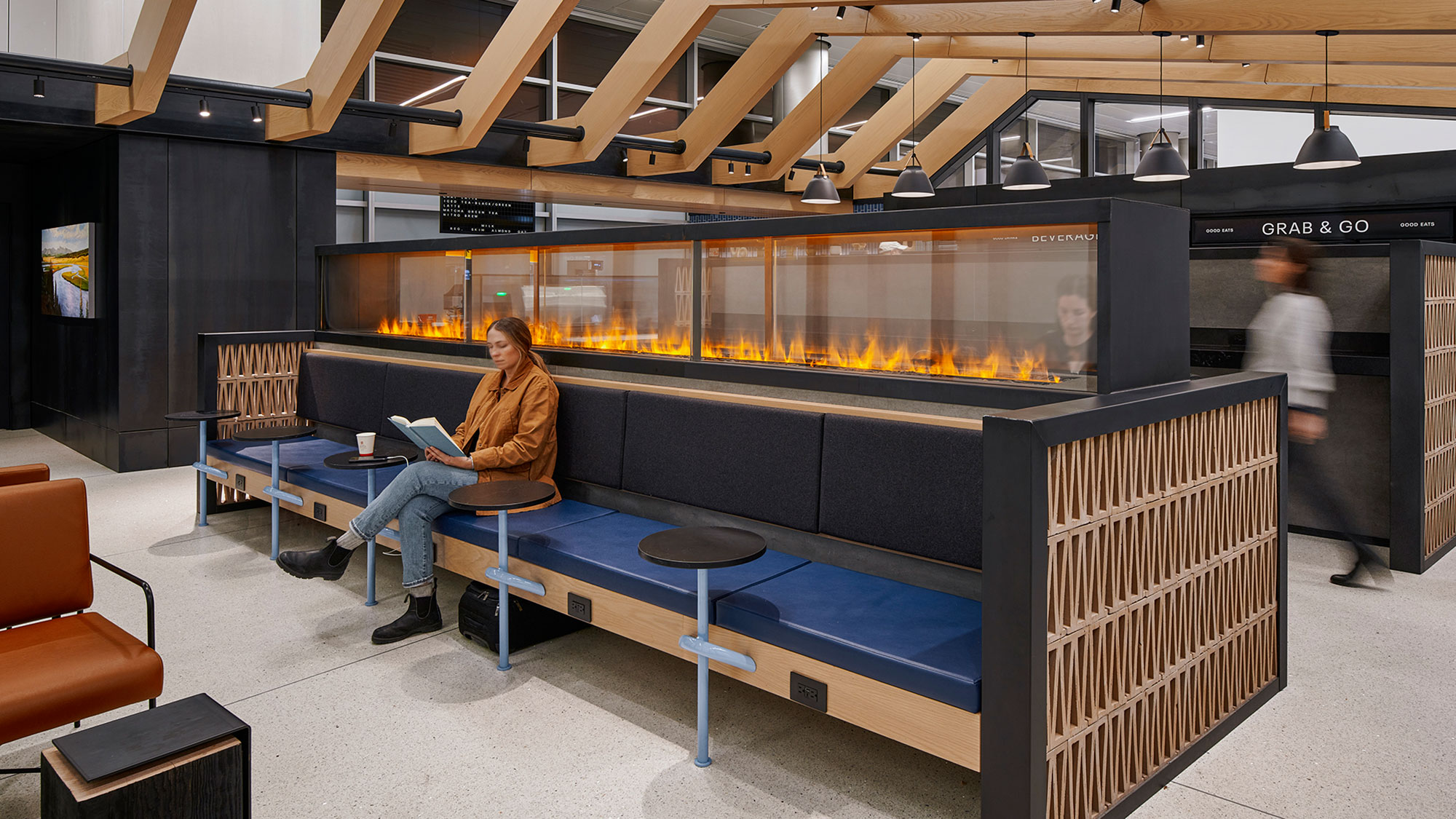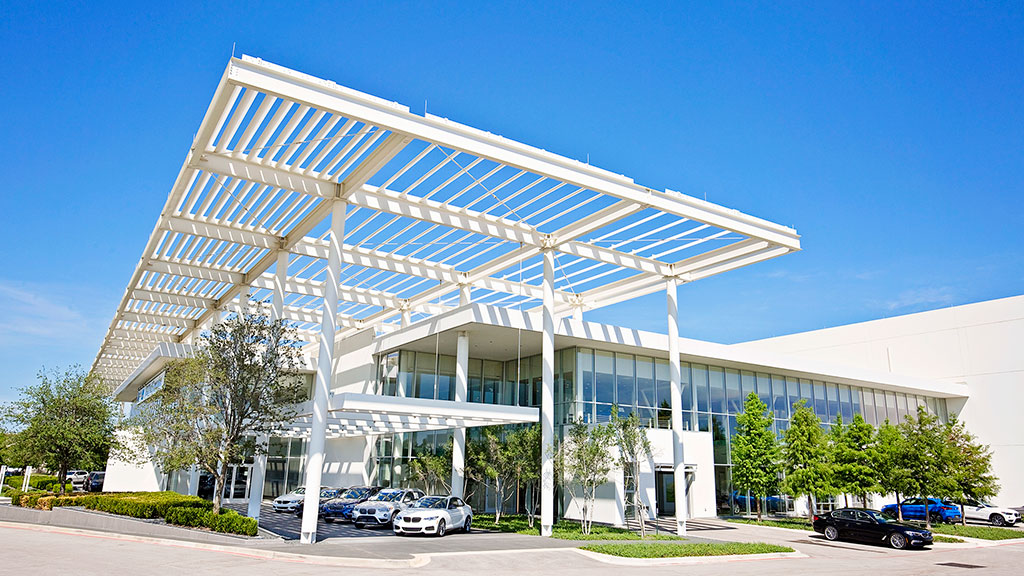The EV Revolution — And Why Charging Stations Are So Critical
September 13, 2023 | Q&A with Dylan Jones, Mark Brungo, and Ashley Dowell
Editor’s Note: for this Q&A, we sat down with Dylan Jones, a global leader for Gensler’s Cities Sector and Mobility practice area; Mark Brungo, Gensler global account director and account leader with Electrify America; and Ashley Dowell, a design director in the firm’s aviation practice.
EVs really seem to be having a cultural moment this year. What do you make of it?
Dylan Jones: It’s interesting because there is so much thinking and attention being devoted to the vehicles themselves. The advancements there are nothing if not mind-blowing. But there’s this whole other side to it, and that’s EV charging. That space hasn’t really been uncovered yet. We know what EV charging is like now, and it’s not pretty. In most cases it’s just a cable you walk up to, and people have nowhere to walk their dog or go to the bathroom. The charging experience itself didn’t come up in those commercials.
Mark Brungo: It’s such an exciting time for the EV market, but the issue is the infrastructure — and the work that still needs to be done to it. That’s a gap we’re going to have to fill quickly.
Dylan Jones: You see a lot of these stories come out that all go the same way: “I tried to take a long road trip in my EV, and here are all the reasons it was a really difficult experience.” That’s something we want to tackle as designers. It’s not just that we need more charging stations. We need to elevate their quality, too.
What does the ideal EV charging station look like to you?
Mark Brungo: You want to reduce charge time as much as possible. That seems to be what all EV groups are most invested in right now. That’s different from what you see in typical retail and hospitality spaces where you want dwell time. A café, for example, wants you to stay as long as possible. So the ideal charging station will be able to balance getting more throughput while making sure the time people spend there is much more engaging, educational, and gives exposure to your brand.
Dylan Jones: Think about something like a gym. How long does someone typically spend there? An hour? That matches almost perfectly with how long it takes to charge a car. The same goes for taking a Zoom call for work or having a quick meal. To me, we need to explore consumable experiences that match the time it takes to charge. We need to think of charging differently than the refueling we experience at gas stations.
Mark Brungo: There are so many opportunities to create moments that fuse hospitality and education; for instance, our work with Electrify America, the largest public fast charging network in the U.S., includes educating the consumer on issues related to electric vehicles. It’s easy to imagine how, depending on the brand and funding source, such spaces could become event hosts, exhibitions for local artists, or community gathering places.
Dylan Jones: It makes me think of the work we did for HanaHaus in Palo Alto. That project reimagined a historic site as a hybrid café, coworking space, and public venue. Designed to support entrepreneurs throughout the entire start-up process: from the chance meeting of potential collaborators or investors at a shared table, to the brainstorming of ideas in a conference room, to pitching an idea over coffee, to presenting the final product on stage. There’s no reason why a membership-based charging station network couldn’t offer the same, and better respond to a workforce and lifestyle that on the one hand is increasingly mobile, and on the other craving local in-person experiences.

Gas stations aren’t exactly a beloved part of American infrastructure. Are there ways charging stations can do better?
Dylan Jones: I think we can do this in a way that better connects travelers to local communities. At a typical gas station, you pull up, get what you need, don’t talk to anybody, and leave. But if you’re hanging out in a programmed space informed by local community offerings while charging, you’re going to engage with other people and in the local culture in a much more meaningful way. Automobility is very isolating compared to the much more civically engaged social experience of public transit. Charging experiences have the ability to inject some of the positive attributes of civic engagement into the system. It could make an important difference.
Mark Brungo: It’s such an opportunity to engage with the customer and educate them. You have a captive audience that has already bought into the idea of EV. These people have something in common with one another. What we’re asking is how can we leverage that to educate people further? What about inserting an incubator lab space for an emerging company?
Dylan Jones: With gas stations, we think of them as a stop along the way. We don’t think of them as the stop. That’s going to be a significant shift in mentality here.
EV charging stations seem to have a lot in common with airport lounges. There, you also have a captive audience with an hour or so to burn. Are there similar considerations for designing those spaces?
Dylan Jones: That’s exactly right. We’re thinking about these types of places that may offer a hospitality amenity experience to alleviate some of the pain points associated with EVs at this moment. We’re trying to look around the corner and see what’s coming in terms of what these spaces will become. So, we’re asking: How long does the average person sit in an airport lounge? What are their pain points? What do they need?
Ashley Dowell: It’s very similar. You’re mid-trip, you need somewhere to sit down and recharge your devices, take a work call, maybe have coffee and a small meal. It’s better than waiting in the terminal and meets the needs of varying guests. Most of the smaller lounges we design have a similar dwell time, ranging from 15 minutes to a few hours. We’re designing very purposefully for what human beings want and need within that timeframe.
Dylan Jones: I’ve heard stories about airports that have such great offerings that people will land and have dinner there before going into the city. So, you have people spending time there 100% of their own choice. We know this level of experience can be accomplished. The same could happen in other mobility realms.
What makes an airport lounge work well? What are these spaces offering to travelers and to the airlines from a business perspective?
Ashley Dowell: It’s interesting — lounges are amenities to their airlines, but some people are choosing to fly certain airlines because of the amenities. They have designs inspired by their local setting and people are proud to check off which ones they’ve visited. The membership becomes a way to connect with this whole community, especially among people who frequent the same routes. It a big deal for airlines to differentiate themselves from one another and generate strong brand loyalty, and this is one way to do it.
Ashley, you’ve designed an array of airport lounges around the world. Is there an example you’re particularly proud of?
Ashley Dowell: United Airlines just opened United Club Fly in Denver, which has been in the works for a few years, a new concept for the airline. It’s designed for people to spend anywhere from 15 minutes to an hour. It has grab-and-go refrigerators from which members can grab whatever they want and a station to fill your own water bottle. We brought in a water vapor fireplace (since gas was not allowed in the airport in a move to a more sustainable future) that introduces a hospitality layer that makes the space feel inviting and more permanent than a pop-up. There’s a barista who can print a custom design — even your face! — into the foam on your latte. It’s memorable and perfect for a quick pass-through.
A small back of house allows for ease of maintenance and operations. We engaged local trades and manufacturers for some of the project’s memorable moments, a practice you’re certainly going to be considering for the sustainability aspect of EV charging stations.

So far, we’ve focused on things from the EV driver’s point of view. What about real estate holders? Or companies looking to get into the EV charging space?
Dylan Jones: It should be a serious consideration for any retailer with the space. I was having a conversation with a broker in Malibu, who held a dying anchor and they were struggling. As a temporary measure they put in a fast-charging Tesla station there, and that station started to drive more money into the main line of the mall than the anchor ever had previously. Now they’re rethinking their entire portfolio.
Mark Brungo: If it’s a station owned by a specific EV brand, how about bringing a car in and using it as a direct touchpoint to engage with the customer, just like you would at a dealership? A lot has changed for brick-and-mortar retail due to online shopping and the desire for an elevated experience. Here, you have an opportunity to guarantee the physical presence of a consumer and make an in-person connection to the brand.
Dylan Jones: It’s also a unique cost situation for the operators. What we learned in working with one startup is that the costly hardware that goes into an EV charging station is significant, but the electricity is cheap. What this means is that the margins are tight for the whole operation. From my perspective, it has to be about something other than the electricity itself to make the enterprise work financially. It could be that when you buy a particular electric vehicle, you get access to a network of great drop-in co-labs, some network of experiential centers as part of the offering. Everybody’s looking for the magic mixture of elements to make this work.
This seems like a situation where design could make a real difference. Do you have any parting thoughts you’d like people in the EV charging market to remember?
Ashley Dowell: We’ve already seen this lounge trend make the built environment a better place for people in so many ways. It’s true for airports but it’s also true for car dealerships that offer places for respite to make the waiting experience so much richer than it used to be. It could clearly get some traction in the EV charging space.
Mark Brungo: This will be a huge opportunity for companies that can seize it. How can we design these spaces to provide users the best possible experience and educate them to help people become better environmental stewards? That’s such an exciting solution to be a part of.
Dylan Jones: The charging stations are going to be a crucial part of EV adoption. At the end of the day, if the charging experience is terrible, it could negate the amazing engineering and innovation that went into creating the EVs themselves. We’ve got to capitalize on it instead.
For media inquiries, email .


